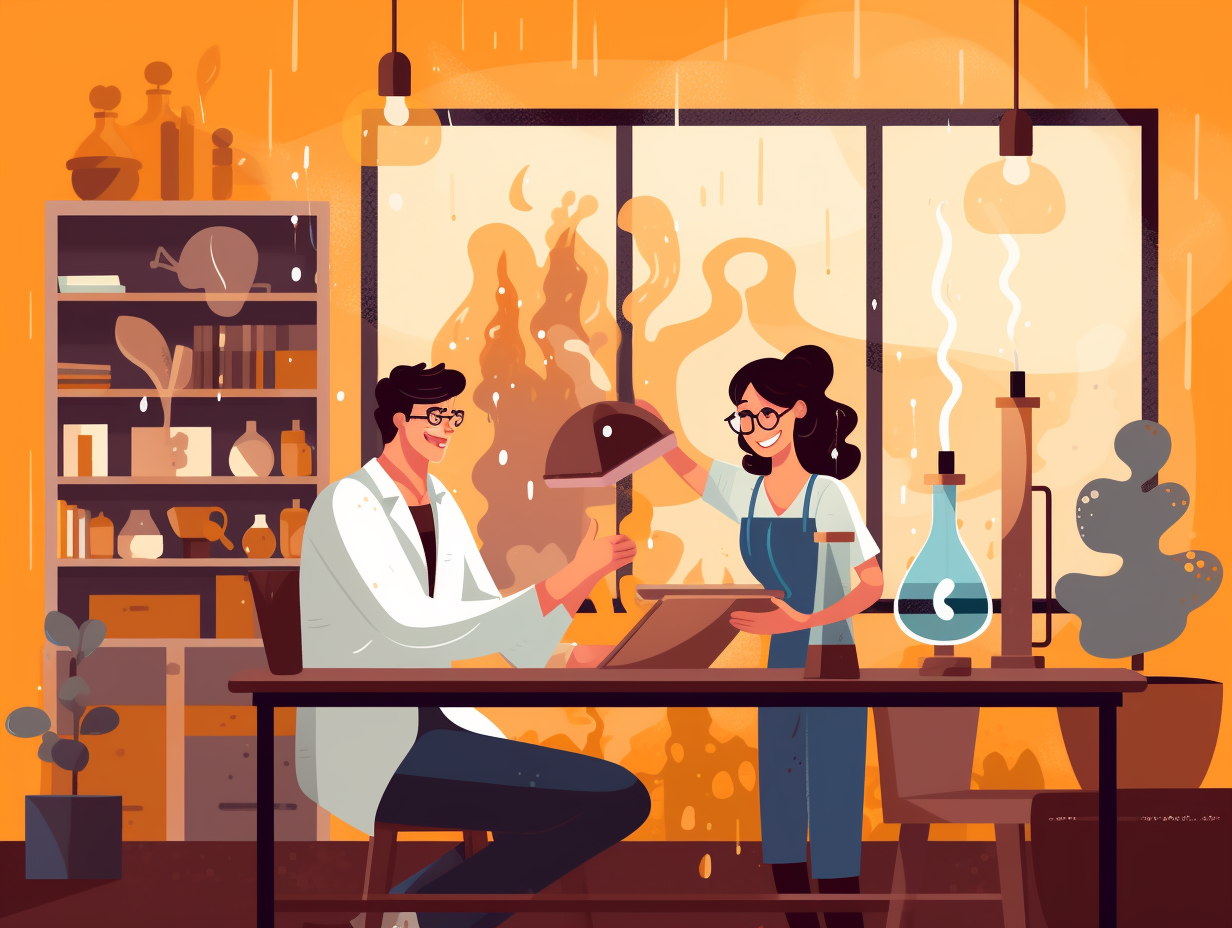Chemistry Chronicles: Discover the Top 15 Fascinating Fun Facts You Never Knew!

1. Banana Radiation: Harmless and A-peel-ing!
Fear not the banana's atomic embrace, for it won't drive you bananas: Although they contain the radioactive isotope potassium-40, you'd have to wolf down a thousand bananas in one sitting to get the same level of radiation as a single chest x-ray, and your body's natural potassium component prevents a buildup of the radioactive type.
Source => mcgill.ca
2. Helium: The Introverted Superfluid
Helium: the introverted, misunderstood wallflower of the periodic table, who refuses to get close to others and needs a little pressure to solidify any relationship. Hilarious prelude: Unlike other elements, helium won't turn solid under ordinary pressures, but it does need higher pressure to enter a solid state due to its tiny mass and weak atomic bonds. At temperatures below 5.2 K, helium turns into a liquid, lovingly dubbed He I, and at just around 2.17 K, it faces a dramatic phase change into He II, a superfluid with some pretty cool quantum properties!
Source => chemistry.stackexchange.com

Did you know that atoms are experts at social distancing? Discover how 99.99% of empty space within atoms plays a huge role in the world of particles!
=> Fun Facts about Atoms
3. Doorknobs and Cyanobacteria: Oxygen Heroes
Who knew that prehistoric bacteria and doorknobs would have so much in common? They both held the key to unlocking a breath of fresh air: Cyanobacteria, through photosynthesis, released oxygen steadily over 200-300 million years, leading to the Great Oxidation Event and the formation of the ozone layer, creating a more hospitable and picturesque Earth!
Source => asm.org
4. Moonwalking on Liquid Mercury: Dangerously Fun
Ever dreamed of walking on water? Well, how about upgrading your dream to moonwalking on liquid metal instead: Mercury, a liquid metal at room temperature, is so dense that lighter objects like humans can float on its surface, but be warned - this thrilling activity could be your last tango due to mercury's highly toxic nature.
Source => nerdist.com

5. Energizer Bunny Meets Opera: Quartz Watches
Quartz watches: the secret love child of Energizer Bunny and a tiny, invisible opera singer! In reality, these innovative timepieces require a battery to send electric love notes to a quartz crystal, which then blissfully shakes and quivers at an astonishing 32,768 times per second. The circuitry chaperone plays matchmaker, transforming these intimate vibrations into electric pulses that whisper sweet nothings to the watch's motor, causing the hands to dance gracefully around the clock face.
Source => uk.mondaine.com
6. Overcoming the Seven-Fold Paper Limit
Oh, the trials and tribulations of origami enthusiasts: continually thwarted by the laws of physics after a measly seven folds of a standard piece of paper! But fear not, magnificent paper-folders! Science and engineering have swooped in like a precisely-creased crane, introducing materials robust enough to be folded over 100 times without breaking or losing their properties – a breakthrough as vital to the realm of advanced electronics and space equipment as it is to your ambitious paper-folding endeavors.
Source => boundlessbrilliance.org
7. Diamond Rain: The Gas Giant's Bling
You've Got Diamond Rain: On gas giants like Jupiter and Saturn, a sparkling shower of diamonds occurs when graphite or soot is subjected to immense pressure within the planets' atmospheres, growing larger and heavier, only to melt into liquid and form diamond "rain" as they plunge into the depths of these cosmic giants.
Source => ck12.org
8. Medieval Alchemists: Chemistry's Rock Stars
Before there was Walter White "breaking bad" in his makeshift chemistry lab, there were medieval alchemists, whipping up potions that were worth their weight in gold: These ancient scientists not only dabbled in the transmutation of metals and the quest for immortality but made significant strides in fields like metallurgy, glass-making, steel development, textile dyeing, and cosmetics. Pioneers like Jabir Ibn Hayyan laid the foundation for the classification of chemical substances, while Paracelsus fused chemicals and medicine, thus fathering toxicology. So next time you ace a chemistry quiz, remember to tip your hat to these forgotten rock stars of science!
Source => aggietranscript.ucdavis.edu
9. Vintage Water: Solar System Edition
When in doubt, check if your water's got vintage swagger: Our solar system's water actually predates the Sun itself, tracing back to the origins of the universe. Thanks to the Atacama Large Millimeter/submillimeter Array (ALMA), astronomers discovered that water composition remains unchanged through various stages of formation, meaning the water we have today is the same as it was during the protostar, protoplanetary disk, and comet stages, making our liquid acquaintance a H2O-ldie but a goodie.
Source => popularmechanics.com

10. Rust's Wild Electron Party
Does rust sleep? Nay, it parties all night in a swirling iron rave, trading electrons like glow sticks: The rusting of iron is actually a complex chemical dance featuring oxidation of iron, water participation, and an encore of iron oxide formation, defying the simplicity once attached to just oxygen and metal interaction.
Source => byjus.com
11. Lemons and Aqua Regia: Gold Disintegrators
When life gives you lemons, make aqua regia: a potent concoction of nitric and hydrochloric acid that can dissolve gold and platinum, creating metal purity levels of up to 99.999%. This fearsome mixture not only tackles Earth's most lauded treasures but also played a vital role in preserving Nobel Prize medals during World War II from the clutches of greedy invaders.
Source => edu.rsc.org
12. Ocean Salt: Poseidon's Flavorful Mix
If Poseidon hosted a dinner party, he'd have quite the mineral medley for his guests to indulge in: The ocean's saltiness actually stems from two unique sources - a delightful blend of eroded land rocks dissolved by slightly acidic rainwater and hydrothermal fluids released from seafloor openings, imparting flavorful metallic notes of iron, zinc, and copper. So next time you visit the beach, appreciate the deep-sea seasoning chemistry behind every briny wave!
Source => oceanservice.noaa.gov
13. Cellular Respiration's A-Team Enzymes
Did you hear about the cellular world's hottest dance crew? They're breaking it down with their ultra-exclusive lineup that keeps the energy flowing all night long: Introducing the tireless trio of phosphofructokinase-1, pyruvate dehydrogenase, and isocitrate dehydrogenase! With a fierce reputation for setting the pace, these rate-determining enzymes steal the show by catalyzing the slowest, yet most essential reactions in cellular respiration. Talk about a molecular A-Team!
Source => osmosis.org
14. Fireflies: Nitric Oxide Dance Party
Lights out, no one's home – or should we say, no nitric oxide's home! When fireflies want to throw a light-up party: It's nitric oxide gas that controls their bioluminescent flashes by regulating oxygen flow into their light organ, ultimately creating their mesmerizing glow show.
Source => scientificamerican.com

15. Vanilla: The Pricey Spice Sweetheart
Feeling a little *spice* in the air? Hold onto your vanilla wafers because this sweet staple is breaking the bank: Vanilla is the second most expensive spice globally, after saffron, due to its labor-intensive cultivation process, taking up to a year to produce high-quality vanilla from pollination to curing and drying. No wonder synthetic versions are taking over, and we're left with only 1% real bean action in the vanilla flavor market!
Source => newdirectionsaromatics.com
Related Fun Facts




















